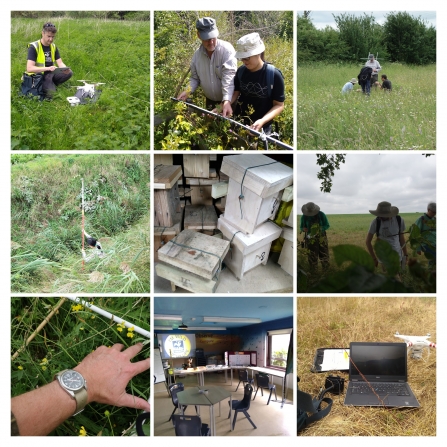Our busiest period tends to be the spring and summer months – we need to be out surveying when certain species are active and when plants are in flower.
We are now into the third year of our grassland surveys, aiming to get a picture of all of our grassland reserves. The aim of these is to keep an eye on which species are present and how abundant they are. This involves visiting each site and recording the plant species in one metre or two metre squares. We can then assess the condition of the site based on the plants we want to see (positive indicators) and the more invasive species we want to reduce or eradicate.
Management at these sites is targeted at increasing the amount of wildflower species present and avoiding dominance of invasive plants. The results of these surveys can alert us to declines in quality and can be used to tweak the management regime.
We have had help this year from Cambridge University as we are now hosting an internship for those keen to get practical experience of conservation at the Wildlife Trust. Two students joined us this year, helping us with a bit of everything and learning new skills along the way. This year they were learning to identify plants, surveying dormice and bats, helping with drone surveys and even out bashing Himalayan balsam.
Dormouse surveys have continued at Brampton Wood and our other sites. There were very few records early in the year – but things picked up in the summer. Young dormice have been recorded at Brampton Wood where the reintroduction continues to be a success. It is hoped that the ongoing coppicing and conifer removal will continue to increase suitable habitat available for this species. We are working with a number of different groups to build new dormouse boxes including a ‘Men in Sheds’ group and students at Swavesey Village College.
Drones continue to provide new ways of looking at our reserves. We have recently been mapping the conifer at Brampton Wood and looking at the results of the ride management. The drone gives us a very quick and accurate way of mapping that can add to what we do on the ground. This has been particularly useful for helping plan our practical conservation work, including removal of scrub and invasive plant species. If you look on our new website, you will also see videos of our reserves appearing, including recent ones at Titchmarsh and Summer Leys.
Volunteers continue to be a major part of what we do – it would not be possible to carry out the huge variety of surveys on our reserves without your help. Over the past few years, we have tried to provide more information on how the survey data is used through our blogs, facebook group and e-news – all of which can be found on the new website.


